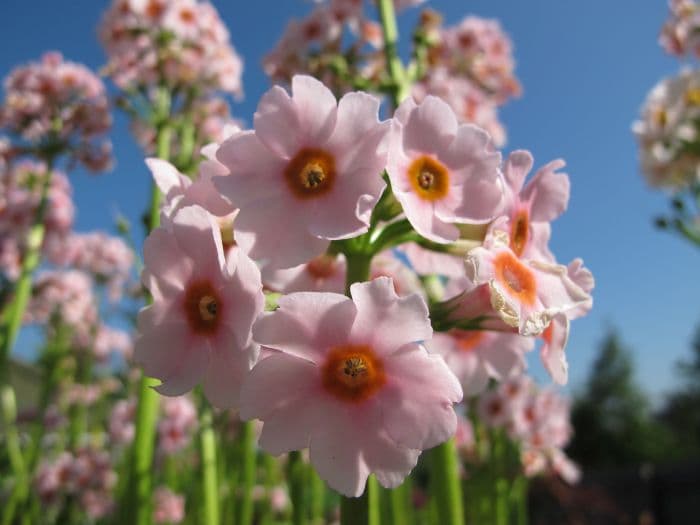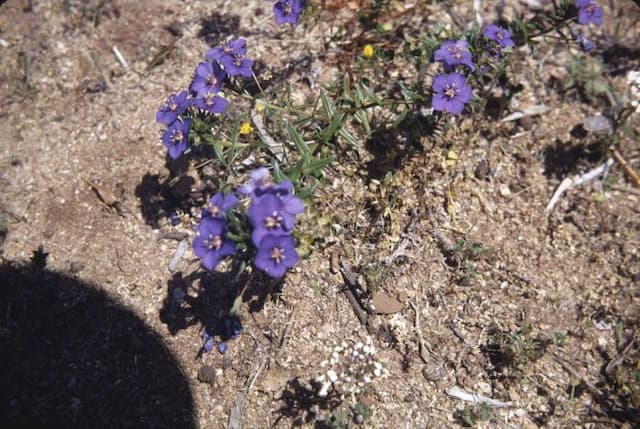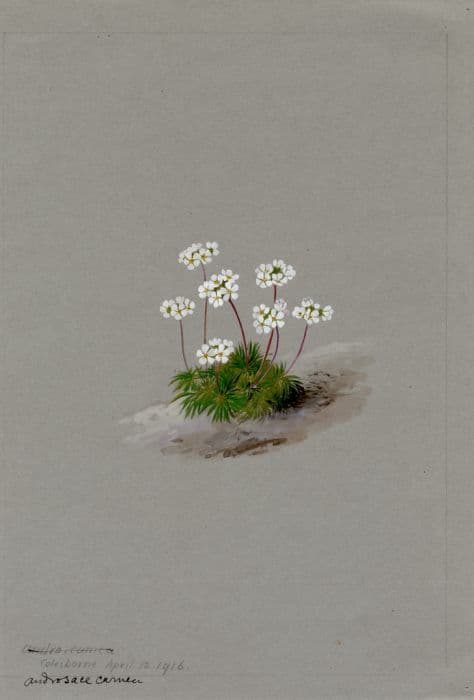Japanese Primrose Primula japonica 'Apple Blossom' (Pf)

ABOUT
The 'Apple Blossom' variety of Primula japonica, commonly known as Japanese primrose, is a charming perennial plant that is celebrated for its distinct and exquisite blooms. The flowers exhibit a delicate pink hue reminiscent of apple blossoms, from which it derives its name. Each individual flower is composed of five rounded petals that cluster together to form an ornate, tiered arrangement, providing a profusion of color. These blooms are supported by sturdy stems that rise above a rosette of basal leaves. The leaves themselves are large, with an almost oval shape, and have a lush, deep green color that offers a rich contrast to the pastel flowers. The edges of the leaves are gently toothed, adding texture to the foliage. Japanese primrose 'Apple Blossom' begins to flower in the spring, presenting its colorful display when many other plants are just starting to emerge from their winter dormancy. This contributes to its popularity among gardeners looking for early season interest. While the plant's overall dimensions are excluded from this description, it is known to fit comfortably in garden spaces without taking over, making it a beloved choice for adding a splash of soft color to borders, beds, and woodland gardens.
About this plant
 Names
NamesFamily
Primulaceae.
Synonyms
Japanese Primrose, Apple Blossom Primrose, Candelabra Primrose.
Common names
Primula japonica 'Apple Blossom'
 Toxicity
ToxicityTo humans
Primula japonica 'Apple Blossom,' commonly known as Japanese primrose, is not known to be highly toxic to humans. However, as with many plants, some individuals might have sensitivity to it, leading to mild irritation or allergic reactions upon contact with the skin or ingestion. It is not typically associated with severe symptoms of poisoning, but if ingested in large quantities, it could potentially cause stomach upset or gastrointestinal discomfort. If a person suspects poisoning or experiences adverse reactions after handling or ingesting Japanese primrose, they should seek medical attention.
To pets
Japanese primrose is not known to be highly toxic to pets. However, individual animals can have different sensitivities, and ingesting this plant could potentially cause mild gastrointestinal upset in some pets. Symptoms of poisoning could include vomiting or diarrhea if consumed in significant amounts. If a pet ingests Japanese primrose and exhibits symptoms of distress, it is advisable to consult a veterinarian.
 Characteristics
CharacteristicsLife cycle
Perennials
Foliage type
Deciduous
Color of leaves
Green
Flower color
Pink
Height
1-2 feet (30-60 cm)
Spread
1 foot (30 cm)
Plant type
Herb
Hardiness zones
5
Native area
Japan
Benefits
 General Benefits
General Benefits- Ornamental Appeal: The Primula japonica 'Apple Blossom' adds aesthetic value to gardens with its delicate pale pink flowers reminiscent of apple blossoms.
- Attracts Pollinators: The flowers are known to attract pollinators such as bees and butterflies, supporting local ecosystems.
- Suitable for Damp Areas: This plant thrives in moist environments, making it ideal for landscaping in damp areas where other plants might struggle.
- Easy to Grow: It's relatively easy to cultivate and maintain, which is great for beginning gardeners and those looking for low-maintenance options.
- Spring Blooming: As a spring bloomer, it provides early color to the garden when many other plants have not yet begun to flower.
- Shade Tolerant: This variety of primula can tolerate and thrive in partial shade, offering flexibility in garden design.
- Cottage Garden Aesthetic: Matches well with a cottage garden style, creating a charming, traditional garden atmosphere.
 Medical Properties
Medical PropertiesThis plant is not used for medical purposes.
 Air-purifying Qualities
Air-purifying QualitiesThis plant is not specifically known for air purifying qualities.
 Other Uses
Other Uses- Candelilla wax substitute: The waxy coating on the leaves of the Japanese Primrose can be used as a vegan substitute for candelilla wax in making candles.
- Natural dye: The petals can be used to produce a light green or yellow dye for coloring fabrics or paper.
- Artistic inspiration: Artists and photographers can draw inspiration from the plant's soft pink blossoms and use them as a subject in their artwork.
- Edible decoration: The flowers of the Japanese Primrose are edible and can be used as a decorative garnish on cakes and desserts.
- Floral arrangements: The upright flowers can be used in cut floral arrangements to add height and a delicate pink hue.
- Botanical studies: The plant can be used in educational settings for botanical studies, highlighting its unique flowering pattern and habitat preferences.
- Garden design: Utilized in shade garden designs for its aesthetic appeal and ability to bloom in lower light conditions.
- Children's projects: The colorful flowers can be used in school projects, teaching children about pollination and plant biology.
- Eco-friendly confetti: Dried petals can serve as biodegradable confetti for outdoor celebrations, reducing environmental impact.
- Plant breeding: Amateur gardeners can use the Japanese Primrose as a parent in plant breeding efforts to create new hybrids with desirable traits.
Interesting Facts
 Feng Shui
Feng ShuiThe plant Primula is not used in Feng Shui practice.
 Zodiac Sign Compitability
Zodiac Sign CompitabilityThe plant Primula is not used in astrology practice.
 Plant Symbolism
Plant Symbolism- Youthful Charm: The soft, delicate appearance of the Apple Blossom variety of Primula japonica resembles the blossoms of an apple tree, which are often associated with youth and the rejuvenating energy of spring.
- Hope and Optimism: As a spring-flowering plant, Primula japonica 'Apple Blossom' symbolizes new beginnings and the optimism that comes with the promise of warmer days and renewed life.
- Love and Affection: Flowers, in general, are often connected to expressions of love, and the subtle pink hues of the Apple Blossom variety evoke a sense of tender love and gentle affection.
- Femininity: With its gentle pink colors and soft appearance, this plant is frequently linked to feminine qualities, celebrating grace, gentleness, and sensitivity.
- Good Fortune: In some cultures, the blooming of Primula japonica is seen as a sign of good luck and is welcomed as an auspicious symbol at the start of spring.
 Water
WaterThe Japanese Primrose should be watered thoroughly, making sure the soil is evenly moist but not waterlogged. During the growing season, water the plant approximately once a week, but this can vary depending on temperature and humidity. Generally, giving the plant about one to one and a half gallons of water every seven to ten days should suffice. It is crucial to reduce watering frequency during the dormant period in the winter, watering only when the soil feels dry to the touch. Ensure adequate drainage to prevent root rot.
 Light
LightJapanese Primrose thrives in partial shade to full shade. It is best to place it in a location that receives filtered sunlight or morning sun with afternoon shade. Avoiding direct, harsh sunlight will help prevent the leaves from scorching. An ideal spot would be under a canopy of trees or on the north side of a building where it can get natural, diffused light.
 Temperature
TemperatureJapanese Primrose prefers cool to moderate temperatures, thriving between 60 to 75 degrees Fahrenheit. It can tolerate minimum temperatures down to 50 degrees Fahrenheit and maximum temperatures up to 80 degrees Fahrenheit; however, prolonged heat may stress the plant. Ensure that the Japanese Primrose is protected from extreme hot or cold temperature fluctuations.
 Pruning
PruningPrune Japanese Primrose to remove spent flowers and encourage a second bloom. Deadheading after the first flush of flowers can promote a tidy appearance and potentially a second, albeit smaller, flowering. Pruning is best done immediately after the initial blooming period. Light pruning can also take place in late winter or early spring to remove any dead or damaged foliage from the plant.
 Cleaning
CleaningAs needed
 Soil
SoilJapanese Primrose 'Apple Blossom' thrives in moist, well-draining, rich soil with a high organic matter content. Aim for a soil pH of 6.0 to 7.5, slightly acidic to neutral. A mix containing peat moss, garden loam, and perlite is ideal to retain moisture and ensure good drainage.
 Repotting
RepottingJapanese Primrose 'Apple Blossom' should typically be repotted every one to two years to refresh the soil and accommodate root growth. It's best to repot in the spring just after flowering or in the early fall.
 Humidity & Misting
Humidity & MistingJapanese Primrose 'Apple Blossom' prefers high humidity levels. Maintain a humidity of around 50-60% for optimal growth, but they can tolerate a range if the soil moisture is adequate.
 Suitable locations
Suitable locationsIndoor
Place in bright, indirect light and keep the soil moist.
Outdoor
Partial shade, moist and well-drained soil.
Hardiness zone
4-8 USDA
 Life cycle
Life cycleThe Primula japonica 'Apple Blossom', commonly known as the Japanese Primrose, begins its life cycle as a seed, germinating in cool, moist soil in the spring. Once the seedlings emerge, they grow into rosettes of green, oval leaves. Flower stems develop in late spring to early summer, bearing tiers of delicate, apple blossom-pink flowers with a yellow eye. After pollination by insects, the flowers produce small capsules containing numerous tiny seeds. As summer progresses, the plant dies back and enters a period of dormancy, with the roots remaining viable underground. The following spring, the plant re-emerges from its rootstock, restarting the cycle with new foliage growth.
 Propogation
PropogationPropogation time
Spring to early summer
Propogation: Primula Japonica 'Apple Blossom', commonly known as Japanese Primrose, is often propagated by division. The ideal time for dividing this plant is in late summer to early autumn when the plant is dormant. To propagate by division, carefully lift the entire plant out of the soil, making sure to keep as much of the root system intact as possible. Using a sharp knife or spade, split the clump into smaller sections, each with a good amount of roots and several growing points or leaves. Replant the divisions immediately, maintaining the same depth at which they were originally growing, and water thoroughly. This method is an efficient way to produce more plants that are true to the parent and will usually result in flowers the following season.









